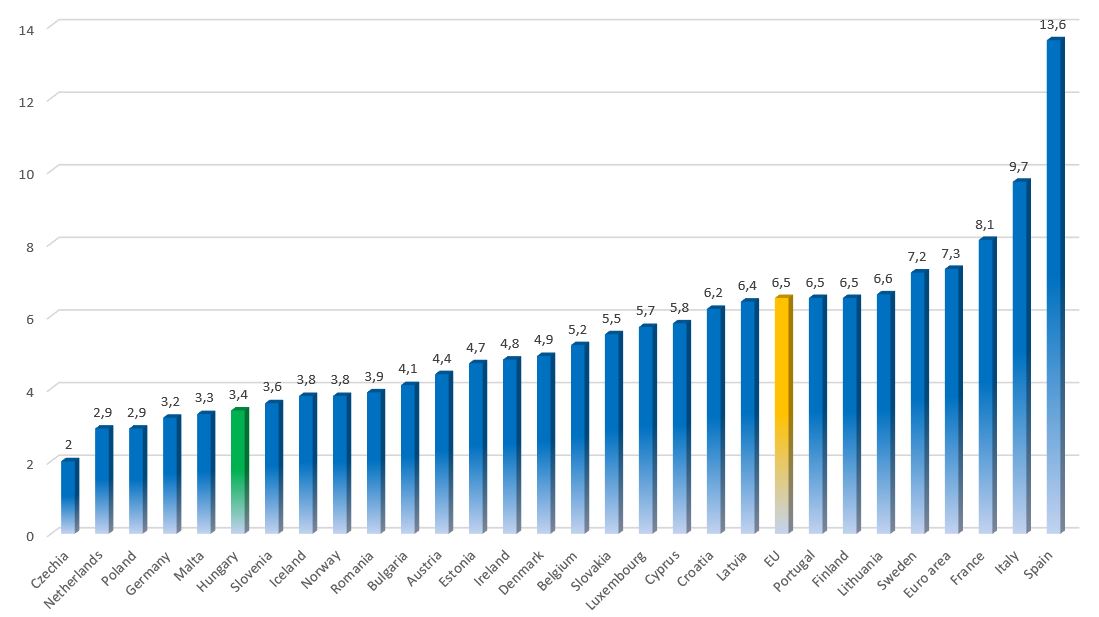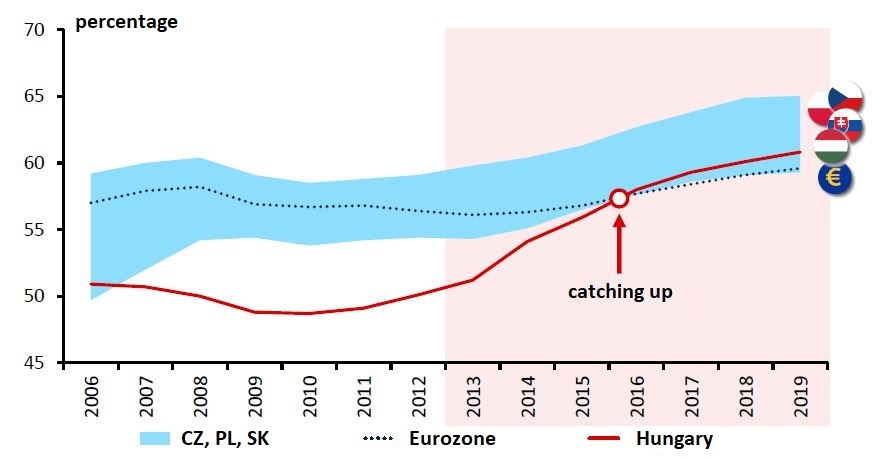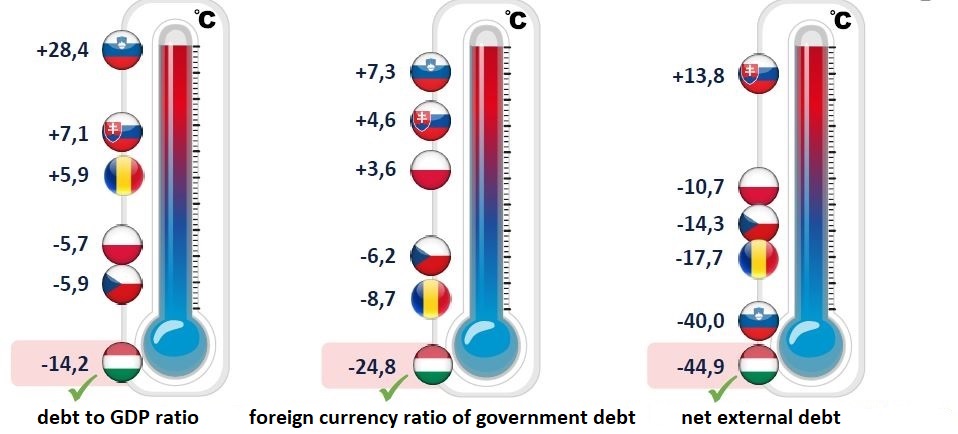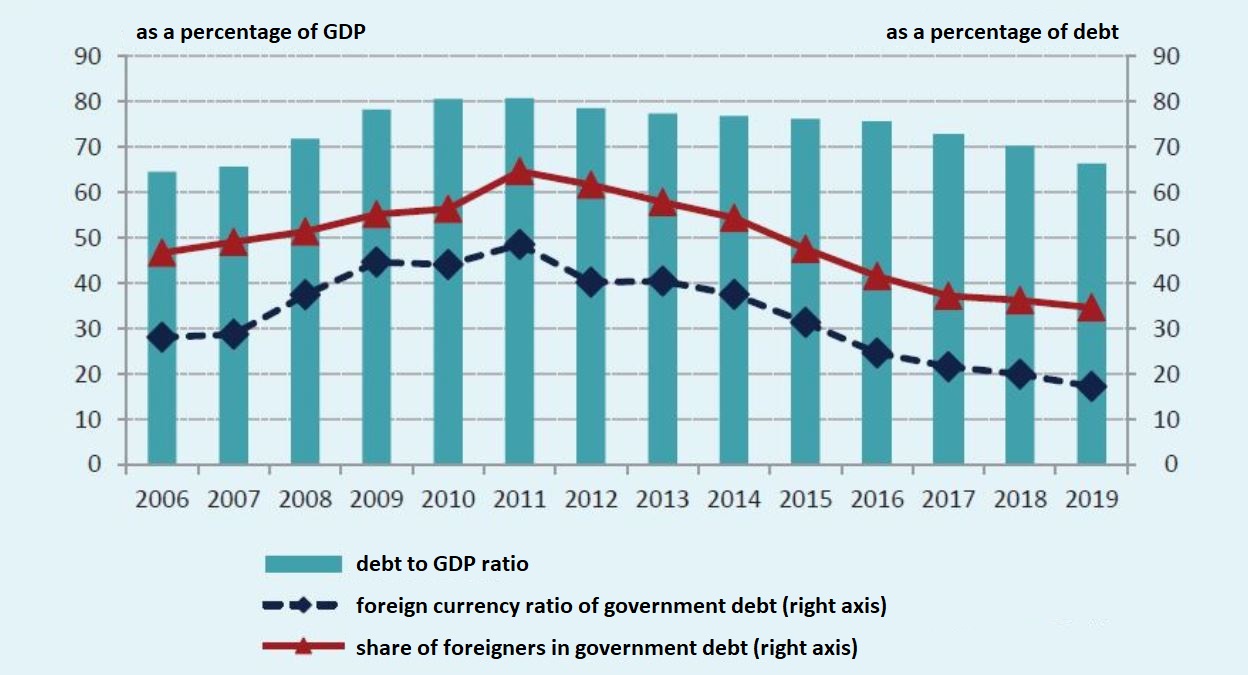How strong is Hungary's immune system?
EnglishHungary's external vulnerability has decreased markedly in the last 10 years. Without the rebalancing measures introduced in the previous decade, the coronavirus epidemic would cause significantly greater economic damage in Hungary. The lower level of the net external debt, the lower foreign currency ratio of the government debt, the disciplined fiscal policy, the conversions of retail foreign currency mortgage loans and the spread of fixed-rate forint mortgage loans make Hungary less vulnerable to a possible foreign capital withdrawal or a speculative attack. The HUF 250 billion dividend of the National Bank of Hungary, which the central bank paid into the budget from its profits last year, also helps a lot in crisis management.
Net external debt is at historical lows
Due to the strong external financing position, Hungary's net external debt - the debt of companies, banks, households and the state to foreign participants - decreased by 44.9 percentage points between 2010 and 2019. By the end of 2019, the level of net external debt has fallen below 8 percent of GDP. This trend significantly reduces Hungary's external vulnerability.
Changes in debt to GDP ratio, foreign currency ratio of government debt and net external debt between 2010 and 2019
Source: National Bank of Hungary
Thanks to a disciplined fiscal policy and dynamic economic growth, debt to GDP ratio has fallen by 14.2 percentage points since 2010. The indicator stood at 66.4 percent at the end of 2019.
The foreign currency ratio of government debt has declined by a quarter over the past decade, currently hovering around 16 percent. This provides significant protection for public finances against the weakening of the forint.
The share of foreigners in government debt has also fallen sharply in recent years. This ratio was above 60 percent in 2011. Today, the share of forint and foreign currency debt held by foreigners has fallen close to 30 percent, it has practically halved.
The share of foreigners in government debt, foreign currency ratio of government debt, debt to GDP ratio
Source: National Bank of Hungary
The smaller share of foreigners in public debt substantially reduces the riskiness of Hungary and at the same time protects the country from the destructive effects of possible capital withdrawals. Due to lower external vulnerabilities, the chances of possible speculative attacks are lower and the extent of the damage they cause should be more restrained.
Private sector loan portfolio
Private sector loans to GDP ratio is low, at just over 32 percent. By comparison, in the other Visegrád (V4) countries this value is between 50 and 60 percent, while the European Union average is around 85 percent.
The average of the Visegrád countries is almost twice as high and the average of the European Union is almost three times higher than the Hungarian level. As a consequence, there are huge growth opportunities in the domestic credit market. There is no over-indebtedness.
In addition, households' foreign currency mortgage loans were converted to HUF denominated loans at the end of 2014. In the recent period, households were indebted in fixed-rate forint mortgage loans with strict income limits. Consequently, the weakening forint will not trigger a drastic increase in monthly repayment.
In the absence of mass foreign currency loans, the National Bank of Hungary does not have to tighten as much as in October 2008 due to the weakening of the forint. At that time, as a result of the rapid depreciation of the forint, the National Bank of Hungary was forced to raise the key interest rate by 3 percentage points to 11.5 percent.
With that decision, the leadership at the time wanted to prevent speculative attacks against the forint and the further significant devaluation of the domestic currency. This was necessary after foreign currency loans were quite widespread around 2008 on both the government and retail sides. The situation was further aggravated by the fact that households were indebted in floating-rate loans, meaning that soaring lending rates due to the central bank's drastic rate hike caused a great deal of pain.
At present, however, monetary policy can remain more supportive due to stronger and more balanced fundamentals. Thanks to the above-mentioned achievements, the financing costs of the private and public sectors are also lower.
Prudent fiscal policy
The disciplined fiscal policy of recent years also allows now more budgetary room for maneuver. This year’s one plus one budget originally targeted a one percent deficit and an additional one percent reserve. Thanks to the earlier cautious fiscal policy, crisis management can be much more effective.
Using budget opportunities carefully, the government raised the accrual-based budget deficit target to 2.7 percent, which was necessitated by recently announced stimulus measures.
Huge profits at the central bank
The successful operation of the National Bank of Hungary also contributes significantly to greater fiscal room for maneuver. The central bank accumulated a profit of HUF 250 billion last year, which it paid into the budget. This amount exceeds 0,5 percent of last year’s GDP.
More than half of the profit, or HUF 137 billion, is due to the fact that the central bank previously increased its gold reserves at right time.
Adequate foreign exchange reserves
The short-term external debt of the Hungarian economy is stably navigating below EUR 20 billion, which also considerably reduces the country's riskiness.
At the same time, the central bank's foreign exchange reserves exceed EUR 28 billion. The Greenspan-Guidotti rule is thus abundantly met, as foreign exchange reserves are over EUR 10 billion higher than short-term external debt, which is closely monitored by investors.
According to the Greenspan-Guidotti rule, foreign exchange reserves must cover the country’s external debt maturing within one year.
The short-term external debt of the Hungarian economy and the level of foreign exchange reserves

Source: National Bank of Hungary
Shrinking balance sheet
Nowadays, central banks can achieve a greater impact with their balance sheet policies than by changing their key interest rates. The Fed and the European Central Bank have also slashed yields in bond markets by launching asset-purchase programmes and thereby increasing their balance sheets.
The balance sheet of the European Central Bank rose to nearly 40 percent of the eurozone economy even before the coronavirus erupted. The National Bank of Hungary, on the other hand, carried out a conscious balance sheet reduction in preparation for the more difficult years.
The National Bank of Hungary ‘s balance sheet fell close to 27 percent from 40.7 percent in 2010. A smaller balance sheet increases usability of unconventional assets and at the same time reduces the central bank's interest rate risk. In light of this, the National Bank of Hungary still has sufficient room for maneuver in the event of an emergency.
The banking sector is also strong
The domestic banking system is in a much better condition now than it was in 2008. The capital adequacy of banks was around 18 percent. The nonperforming loan ratio was below 5 percent last year. Banks' risk-taking has also been modest in recent times.
Today, a numerous rules and monitoring tools ensure that the systemic problems seen after 2008 are not built up again. Currently, the stock of qualified fixed rate mortgage loans can be estimated at HUF 1000 billion. The vast majority of newly taken mortgages have a fixed interest rate.
Unemployment is rising from a low level
The unemployment rate fell to 3.4 percent by the beginning of the year, while the employment rate for those aged 15 to 74 rose to 60 percent, a historic high. Thus, the coronavirus hit the domestic labor market in a strong, healthy state, when the full employment level was close.
The domestic unemployment rate was also low compared to the countries of the European Union (percentage)

Source: Eurostat, növekedés.hu
Thanks to dynamic and broad-based economic growth, employment in Hungary has increased by more than 800 000 during the last decade. While in 2010 only 3.7 million people worked in Hungary, in 2019 their number increased to 4.5 million.
Employment rate in the 15-74 age group



